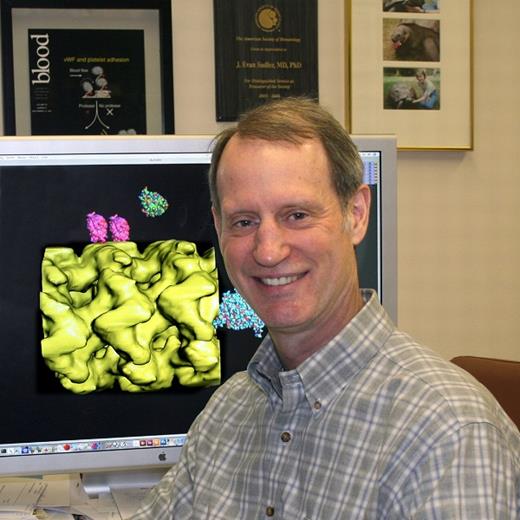J. Evan Sadler III, MD, PhD, the Lang Professor of Medicine and Chief of Hematology at Washington University in St. Louis, passed away on December 13, 2018, after a brief but devastating illness. Evan was 67 years young, an outstanding academic hematologist, and a great citizen of science and life.
Evan was born in West Virginia and showed incredible intellectual promise and curiosity from a young age. That promise led Evan to Princeton, where he graduated Summa Cum Laude and Phi Beta Kappa, majoring in chemistry. Evan then entered the MD/PhD program at Duke University where he trained with Bob Hill in enzymology and protein biochemistry, as Evan put it years later, disciplines fundamental to learning how molecules worked. This was a productive time for Evan, both scientifically and romantically, as he met Linda Pike, a PhD student in Bob Lefkowitz’s laboratory, forming an incredible couple, ultimately giving rise to what Evan referred to as their F1s — Brooke and Evan D.
Following his MD/PhD training, Evan remained at Duke for his internal medicine residency, followed by a hematology fellowship at the University of Washington in Seattle, training in the laboratory of Earl Davie. For those of us who trained with or were aware of Evan in his early career, it was clear that he was an incredibly intelligent, precise, and inquisitive scientist, and a serious student of all things scientific. During a visit to the Galapagos Islands, Evan’s prior encounter with a very old tortoise, which as a turtellet had also been gazed upon by a twentysomething scientist named Charles Darwin, turned the trip into his “best ever.”
As a clinical hematology fellow Evan was intrigued by normal and disordered blood coagulation, so what better research fellowship project for him than cloning the gene for the “factor” responsible for von Willebrand Disease (VWD)? Evan’s successful cloning of von Willebrand Factor (VWF) launched his scientific pathway to hundreds of publications and millions of dollars in sponsored research.
Evan’s early successes led to a Howard Hughes Medical Institute investigatorship, which he held for more than 25 years, and an appointment at Washington University, where he remained on faculty for his entire academic career. During this time, Evan had a profound effect on the field of blood coagulation and its disorders. He was a key thought leader in defining the complex biology and genetics of VWD, and establishing the current criteria for its diagnosis. Evan deciphered the biochemical pathways responsible for the assembly of the 300 kDa VWF monomer into huge, ultrahigh molecular weight molecules that measure microns in length. Along with others, Evan’s work on ADAMTS13, the protease that cleaves ultrahigh molecular weight VWF to the size found in normal plasma, unraveled the molecular basis for congenital and acquired thrombotic thrombocytopenic purpura. The impact of his scientific contributions was recognized by his election to numerous honorific scientific societies, including the American Society for Clinical Investigation, the Association of American Physicians and the National Academy of Medicine, and garnered him multiple awards from the American Society of Hematology and the International Society for Thrombosis and Hemostasis.
But beyond his scientific impact, Evan Sadler embodied integrity and collegiality, setting the tone for our entire field. It never mattered to Evan who did something first or got the credit – what really mattered was solving the scientific problem at hand in the most rigorous fashion. He was a caring mentor to over 50 trainees in his own lab as well as innumerable trainees and junior faculty members at his own and other institutions. Evan gave back to his professional societies, serving on numerous editorial boards and as an elected officer including President of ASH; he also organized a large number of scientific meetings and conferences. Evan was a student of all life, equally comfortable speaking about diverse topics from protein biochemistry to French cooking, or the ethics of Aristotle. He was a devoted father and husband, a ballroom dancer and a runner, and a treasured friend and colleague to so many.
Because of his verve for life, this remembrance of Evan Sadler requires one last story. Wherever Evan traveled, he brought along his running shoes and his stopwatch. One of us (K.K.) ran with Evan whenever we were together, in Bethesda, Bermuda, New Orleans, New Hampshire, and all around the world. The same drive for precision that led to Evan’s scientific success carried over to running. Evan kept the precise duration of our runs, including stopping his stopwatch when we came to a red light, starting it up again only when the light turned green. Seriously. But perhaps the most remarkable example of his drive for precision came when a run in Philadelphia was punctuated by a bout of a heart rhythm disturbance, supraventricular tachycardia (SVT). Because the abnormal rhythm was distressing and reduced his exercise capacity, whenever Evan developed SVT during a run, he stopped, then stopped the stopwatch, performed carotid sinus massage to stop the SVT, before starting the run, and the stopwatch, again. Precision embodied.
Evan Sadler was a scientific and clinical giant in the field of hemostasis, whose contributions to biomedical research and to patient care will live long after him. He was also a wonderfully kind, generous, and warm human being who will be profoundly missed by so many.
With great fondness and respect,
– Kenneth Kaushansky, MD, and David Ginsburg, MD

